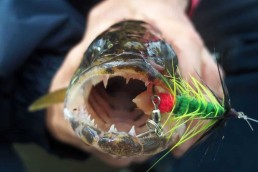The Tale and Tail of a Fishing Innovation that Entices ‘em All
SHARE THIS POST
I’m proud to release the following to the readers of MidWest Outdoors: It’s about a fly with a tail spinner that can be used successfully on a fly rod or spinning rod to catch all game species, even the rough fish. I’m more excited about this than any new fishing lure I’ve seen in 75 years. During four years of testing Gapen’s Spin Bee, “Bobber” Anne and I came upon a new idea for a fly. I’ll divulge the use of the new fly/lure in this issue, and then in the February and March issues.
This ol’ man is extremely excited about this new innovation. The fact that it catches carp and suckers as well as gamefish makes it special. It will give you rough-fish anglers something new to test, and the gamefish anglers who have always wanted to use flies on your spinning rod a fly to use on such gear. I’m also going to challenge all the pros to try this new system and its lure style. Brush aside your prejudices and use this new way to catch the strange, bottom-dwelling fish. You may find that it will challenge your skills and provide a thrill, just as has for me. The love of angling will be heightened, as you too will become hooked on sucker fishing.
North America hosts 56 species of suckers, more than any other, and many of these make excellent table fare. To the many carp clubs that have sprung up across the country: Wouldn’t you want to use an artificial lure to catch the hardest-fighting fish?
I’ve treasured sucker fishing since I was growing up in the wilds of northern Canada. I began running a dog team at age 11, and each fall when the brown suckers run ran up our creek I would gather 55-gallon drums of suckers for dog food. These were chopped up and cooked with oatmeal and the concoction was spread out on a table and left to freeze. This hardened mix was then cut into chunks to feed the dogs in winter. We had redhorse suckers for us as well, food my mother prized for the family in the cold-weather months. She’d have me fillet each red horse like a walleye, cut the fillets into three strips, and then run them through a meat grinder twice. We gathered the suckers with dip nets and spears. They were so thick that our 8-inch-wide spearhead would take three on a thrust. Once I carried a rod and reel along with a can of worms. After two attempts, I hooked my first redhorse. It fought harder than any walleye I’d ever taken, and even broke water. Once at my feet, I saw that its red fins and graceful body made it look as beautiful as ocean fish I’d seen in photos.
Lately, I’ve brought home suckers for my old yellow Lab, Thumper. She too prefers the redhorse suckers.
While we found the success of our Spin Bee lure worked in the Benthic Zone, “Bobber” Anne and I were often confronted with schools of suckers and carp readily coming to the flash of the Spin Bee’s spinner. And with scent from a Red Ball Egg or a tiny piece of angleworm, they attempted to suck in the Bee.
One day in August 2013, as Anne worked her underwater video gear, she called out that she had seen a
redhorse sucker inhaling the Spin Bee. I was using a 1/16-ounce size to attack rock bass and pumpkinseeds. At the time, this was the smallest-sized Spin Bee we made. Then, as suddenly as she proclaimed the sucker had inhaled my lure, she followed with an exclamation that it had spit it out—but I hadn’t felt a thing. This was the beginning of a challenge that would be finally solved in 2014.
We do field tests on all the lures before releasing them to the fishing world. And over the summer of 2014 as we explored the underwater “River Zones,” we continued to use Spin Bees in lighter sizes. A 1/32 ounce was created and it worked better than the 1/16 ounce on suckers and carp. The 1/16 was a killer on all the other river species, such as smallmouths, rock bass and walleyes. But it appeared to be too heavy for the sensitive mouths of the suckers and carp. They continued to reject the Bee, even though they were attracted to it and tried to eat it. The addition of 3/8 inch of an angleworm helped, but the lure’s weight seemed to be the reason for their rejection.
It was late in August 2014 when a decision was made to completely change that lure style.
Are you enjoying this post?
You can be among the first to get the latest info on where to go, what to use and how to use it!
“Anne, what if I tied up a fly in a similar style to the Spin Bee?” I asked, as a suggestion was formulated as I studied Anne’s underwater video to monitor a redhorse spitting the 1/32-ounce Bee out.
“It would be lighter, but still have the attraction of the tail spinner. For weight, we could add a split shot in front of the fly, maybe 7 to 9 inches, which would leave the fly with a fluid, natural action in the water.”
The fish had released the bait without any noticeable “tap” on my rod tip. It seemed the planer board clip we’d been using to hold the Bee to her underwater lens was too heavily set. During previous testing we’d lightened the pressure as much as we could. But even at the lightest setting the sensitive bite of a sucker was too soft to be detected.
To solve this problem, we created a fly version of the Spin Bee. By the addition of a fly, the weight of the jig’s head was eliminated. Before, we were missing five out of six rough fish strikes on a 1/32-ounce Bee, but now, after making this modification, we were now hooking three out of four on the new fly version.
Alas, the Flick Fly was born.
During the following two years of tests, the new Flick Fly proved to be a killer on all gamefish, both freshwater and saltwater. Bass, walleyes, panfish, carp, and most near and dear to my heart, suckers, were all easily being caught. In rivers, the new creation was as deadly as any lure we had ever created. In my mind, I believe this fly/lure is capable of out-fishing our Ugly Bug, a lure Gapen original that continues to produce to this day.
The best thing about the hot new Flick Fly is that it can be used on a fly rod or spinning rod. On a spinning rod, when anglers want to use this, they can just place number 8 split shot 8 inches in front of a size 8 fly. This allows the fly a natural motion and prevents tangling on a cast. If it’s the number 1/0 Flick Fly, the angler is advised to use a number 5 split shot pinched on 10 inches up from the fly. This sees the fly perform properly. On a fly rod, anglers can use this fly/lure just as any other. I’ve found a 7 1/2- foot fly leader performs best with this tail-spinning fly. We’ve tried multiple combinations, and it took an entire summer to compile these results.
Next month, I’ll continue to explore the secrets of designing the new fly, how it works, how we settled on the patterns made in and why these styles will be made. We’ll take you into the waters the Flick Fly works best in and how to present this style of lure. You’ll go with “Bobber“ Anne and me as we are pestered by smallmouths on a June day while attempting to research the fly rigged for walleyes. We’ll describe how to rig for this species in lakes and reservoirs as we’ll as show you how a successful presentation is accomplished on all species. And, I’ll explain how you might rig the Fly on other gear you use.
MWO
SHARE THIS POST
You may also like...
Did you enjoy this post?
You can be among the first to get the latest info on where to go, what to use and how to use it!
Dan Gapen
Considered one of the world’s leading river anglers, Dan Gapen, Sr. has shared his knowledge with MidWest Outdoors readers and viewers for more than 40 years. He is a member of all three Fishing Halls of Fame—International, National Freshwater, and Minnesota. He has an immense grasp of the world’s fisheries. He may be contacted at 877-623-2099.
@TheGapenCompany.



